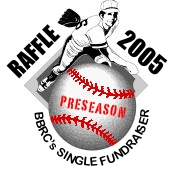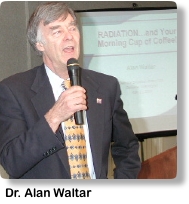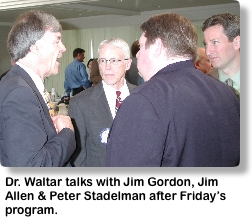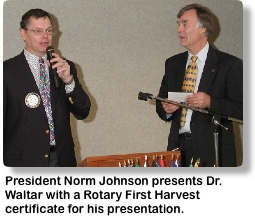|
||||||||||
|
ANNUAL RAFFLE: 2005 Raffle Preseason | About the Raffle | 2004 Raffle Winner |
||
 |
|||||||||||||||||||||||
|
Vol. 17, No. 43, April 25, 2005 IN THIS ISSUE: This Reveille Home Page | The Friday Program: Radiation & Your Morning Cup of Coffee! | How to Get a Date with Sol | It’s RFP Time! | We Get Letters | Friday Potpourri | Stretch Time for RI Foundation | Nicole Wallace Named SOTM | A Mini Club Assembly | EADS Work Party | Web Fun |
|||||||||||||||||||||||
|
|||||||||||||||||||||||
|
The Friday Program:
If Dr. Waltar’s name is familiar, that’s because he was introduced by his son, Steve, who happens to be a member of the BBRC. That’s how we got Dr. Waltar as our guest speaker Friday. Tell you what: we’ve had some excellent programs during this Rotary year, and this was one of them! Alan Waltar was born in Chehalis, graduated from the UW, and went on to the University of California at Berkley for post graduate work. In his introduction, Steve said his father was a former Rotarian and was a “great encourager to his four children.” Dr. Alan Waltar is a former member of the Richland Rotary. He taught at Texas A & M and has been involved in the Fast Breeder Reactor project at Hanford. He is a past president of the American Nuclear Society, and his topic Friday morning was “Radiation and Your Morning Cup of Coffee!” Radiation: it’s all around us. It impacts agriculture, medicine, industry, transportation space exploration, anti-terrorism, and crime. Dr. Waltar showed what kind of industry is this radiation. “The nuclear industry accounts for $73 billion annually, but you’ll be surprised to learn that radiation is a huge industry accounting for annual expenditures of $257 billion and employing 3.7 million people.” Just think of some of the ways radiation is utilized in our modern world: in medicine for sterilization of medical products; drug testing, where 80% of all new drugs are tested with radioactive tagging before receiving approval; in the medical field of diagnosis, where a radioactive source is injected into the patient and then a picture is taken to help understand the patient’s medical problem. Radiation is everywhere in therapy. In cancer treatment, radioactive seeds are placed in men who have prostate cancer. Radiation tells farmers of the minimum amount of fertilizer needed to raise various crops. It results in higher crop production by generating new species and selective breeding from mutations. There have been 250 new crops discovered in this fashion the past 20 years, including several new varieties of wheat.
The concept of food irradiation has been studied more than any other method, reducing parasites in food. It’s been studies for over 40 years and the FDA has approved radiation for spices, poultry, red meat, fish and other prepared food products. Industry depends on machines running with radiation gauges which reduces engine wear. There are many non-nuclear processes, such as drilling for oil by detecting hydrogen that facilitates finding new sources of fossil fuels. In the area of personal care, contact lenses, glasses, band-aids, cosmetics, and baby diapers are just a few of the items that utilize radiation as a means to make sure these products are fit for human use. Transportation uses radiation to check weld safety on cars, trucks and airplanes. Radio-thermal generators using Plutonium 238 heats space crafts and drives instrumentation. One of the biggest applications is nuclear power. If we want to go to Mars, we’ll need nuclear power. The use of radioisotopes will help get us there. In the fields of anti-terrorism, crime and public safety, radiation machines are prevalent in luggage inspections, detecting anthrax in mail, DNA analysis for fighting crime, cutting deaths due to fire with smoke detectors powered with small radiation sensing devices. And, at our ports of call, only 2% of the cargo is being scanned, but that small number stands to increase from now on. Carbon dating through radiation is used in the arts and in science. Determining the age of water sources can be discovered by use of radiation. Environmental protection utilizes radioactive techniques to find pollution, discovering new fresh water sources, guarding the oceans, understanding soil erosion and monitoring chemical pollution. Dr. Waltar emphasized that “global warming is a very serious issue, with radiation technologies helping to identify ways that man may be able to reduce its impact.” Dr. Waltar said that the harnessed atom has already fulfilled useful purposes. In fact, 5% of the Gross Domestic Product depends on nuclear and radiation techniques.
For his presentation, Dr. Waltar was awarded a certificate noting that the BBRC has donated 1,220 pounds of irradiated zucchini to area food banks. After the whirlwind tour of the subject of radiation technologies, President Norm decreed that each Rotarian present will receive “a half-credit toward your latest college degree.” (Can he do that?) Thanks to Steve Waltar for introducing his father to the BBRC. It was an engaging morning. |
|||||||||||||||||||||||
 |
|||||||||||||||||||||||
 |
|||||||||||||||||||||||
|
CLICK HERE |
|||||||||||||||||||||||
|
Reveille | Reveille Archives | Meeting Information | Calendar | How to Join the BBRC | Officers & Directors | Committees | NEW! Member Directory | OLD Member Directory | Short Directory PDF File | Short Directory CSV File | Meeting Make-Up Form | Attendance Statistics | New Member Application (PDF File) | Expense-Funding Request Form (PDF File) | Rotary Foundation Pledge Form | District 5030 Website & Newsletter | Email Us ANNUAL RAFFLE DISTRICT 5030 CLUB INFORMATION
|
|||||||||||||||||||||||



